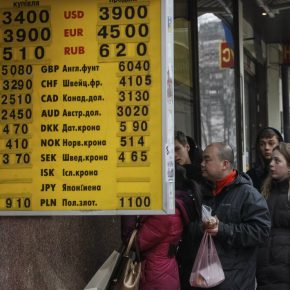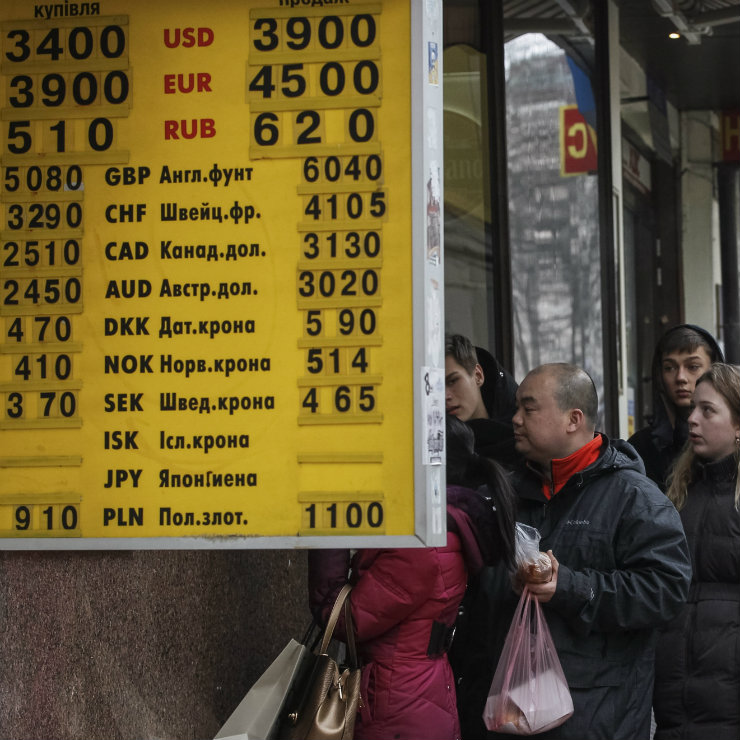Tydzień w gospodarce
Category: Raporty

Money exchange point, Ukraine (©PAP)
The PLN is becoming increasingly popular in Ukraine and its changing position is perfectly illustrated by the situation on the Ukrainian online currency exchange platform. Few years ago, there were only few offers to buy and sell PLN. Today the average daily turnover is several hundred thousand of the PLN. Ale the nature of transactions has changed — several years ago sellers and buyers were mostly tourists travelling to Poland, today they mainly include small importers and exporters.
One good indication of the growing interest and popularization of the PLN in Ukraine is the decreasing difference between the PLN buying and selling prices (bid-ask spread) at the currency exchange offices — in December 2014 it reached 16.5 per cent, then remained at 4 per cent starting from 2017, and has currently dropped to about 2.4 per cent. This is the result of the rise in turnover which brought down the profit margins of intermediaries. Although it is still higher than in the case of the USD, where the average difference in the exchange rate is 1.5 per cent, it is already comparable to the EUR, where the difference is around 2 per cent, and incomparably better than in the case of the RUB — which has until recently maintained a strong position — where the profit margin reaches 10 per cent.
The expansion of the PLN also has a territorial dimension. Just a few years ago it was only traded in the areas located near the Polish-Ukrainian border, in Lviv and occasionally in Kiev. Today, thanks to Ukrainian economic emigrants, it is traded even in very remote parts of the Ukrainian countryside.
The International Organization for Migration (IMO) has calculated that in 2017 economic emigrants from Ukraine sent remittances for a total amount of USD12.1bn to their country. This is more than estimated by the National Bank of Ukraine (NBU), which previously reported the amount of USD9.3bn. These transfers represent 8 per cent of Ukraine’s GDP, if we were to accept the data presented by the NBU, or as much as 11 per cent, if the IMO data is correct.
Remittances from Poland accounted for 33.6 per cent of the total amount (USD3.1bn). Meanwhile, back in 2015, they accounted for 19.1 per cent (USD1.3bn). The data from the first three quarters of 2018 indicate that remittances from Poland reached the amount of USD2.7bn. The rate of growth was 156.5 per cent in 2017 and an additional 20 per cent after the three quarters of 2018.
This means that the foundations for an increase in the volume of the PLN in circulation in Ukraine are strong and undoubtedly beneficial for the real sector of the Polish economy.
Poland is Ukraine’s main trading partner among Central and Southeast European (CSE) countries, as well as its fourth-largest trade partner in the world. “Each year the volume of this trade grows,” stated the Ukrainian Prime Minister Stepan Kubiv.
However, if we take a closer look at the figures provided by the State Statistics Service of Ukraine (Ukrstat), it will turn out that the situation is not as favorable for Poland as it could be. While the trade balance is positive — last year Polish companies exported goods for USD3.63bn to Ukraine and imported goods worth USD3.26bn — Ukraine is really in a better position, because the rate of growth in trade exchange is unfavorable for Poland. In 2018, exports from Ukraine to Poland increased by 19.6 per cent while Polish exports to Ukraine only grew by 5.2 per cent. As a result, the amount of money that Ukrainian emigrants send back home from Poland is almost equal to what Polish companies gain from their exports to Ukraine.
These results put Poland far behind countries whose exports to Ukraine are considerably smaller. In 2018, the value of exports from the United States to Ukraine was USD650m lower than the value of exports from Poland, but that country still managed to achieve a positive trade balance of USD1.85bn. Meanwhile, France has a trade surplus three times bigger than Poland, even though its exports to Ukraine only amounted to USD1.5bn. Moreover, France achieved this result despite the 5.6 per cent decline in the value of exports in comparison with 2017. Lithuania, which sold goods to Ukraine for just USD877m, achieved a trade surplus of USD534m. A number of other countries have a balance of trade with Ukraine that is much better than Polish: the Czech Republic reported a surplus of USD157m, with exports amounting to USD1bn and an export growth rate exceeding 19 per cent; the United Kingdom has a trade surplus of USD303m with total exports of USD888m; Sweden recorded a surplus of USD395m with exports worth USD465m; Canada achieved a surplus of USD255m with exports only amounting to USD333m. In addition, all the countries mentioned above, except for France, have a higher rate of growth in exports than Poland.
The popularization of the PLN in Poland’s trade with Ukraine would undoubtedly stimulate its growth and a change in its structure into a more favorable for Poland. A Ukrainian importer intending to buy goods abroad has two basic decisions to make — selecting a supplier and the currency in which the contract should be settled. If the PLN is widely available and popular on the Ukrainian market, he will consider a supplier from Poland rather than settling the contract in a different currency.
This would also help in dealing with the exchange rate risk, which — in conditions of economic instability — can cause serious disruptions and hurt the financial results of the transaction, and sometimes even lead to business deals being cancelled.
How that works in practice can be seen on the example of the 2011 crisis and the associated abrupt devaluation of the PLN against the USD — the most popular currency used in trade contracts between Poland and Ukraine. Within just a few weeks from August to October, the PLN rapidly depreciated against the USD, while Ukraine maintained a fixed exchange rate of the UAH against the USD. As a result, although both currencies were included in the same Eastern European currency basket, one lost its value, while the other did not. The USD-denominated contracts between Polish and Ukrainian entrepreneurs, which had been profitable for both parties up to that point, became a harmful burden for Polish importers of Ukrainian raw materials almost overnight. On the other hand, when the PLN strengthens in relation to other currencies, this hurts the Polish exporters whose product priced in the foreign currency equivalent becomes more expensive for the final recipient, even though its price on the internal market does not change — Polish entrepreneurs exporting goods to Ukraine have experienced this many times.
Unfortunately, almost all the earnings of Ukrainian emigrants sent back home from Poland — PLN12bn in 2017 and more than PLN10bn for the three quarters of 2018 — are still converted into USD and the EUR before they are transferred. This conversion breaks up the relationship with Poland’s economy, which would be maintained if the remittances were denominated in the PLN.
The popularization of the PLN in Ukraine would be particularly important for the future of the Intermarium concept. Deprived of an economic component, this project would be weak compared to the competing projects of regional integration.
However, it is difficult to talk about an economic component without a currency. Due to the market size of the countries that would supposedly form the new bloc, the only currencies that could even be considered are the PLN and the UAH. However, the latter stands no chance in view of the difficult situation of the Ukrainian economy and public finances. By way of elimination, the financial lynchpin of the Intermarium project would have to be the PLN, and the natural way to build its regional position could be to first popularize it in the trade exchange between the two largest economies of the proposed bloc.
In this context, it is worth going back to the opinion presented by Amanzhol Koshanov, an economist from the Academy of Sciences of the Republic of Kazakhstan. In 2012, in the analysis of the economic foundations of the Customs Union developed by the Russian Federation, he captured the situation of other regional blocs, including the Intermarium. „In the conditions of independence of states within separate regional blocs, some currency should play a dominant role. Supranational currencies within the framework of regional alliances can take their position in two ways. The first is to introduce a supranational unit of account denominated in the currency of the leading country. The second is a situation in which one of the currencies of the regional bloc’s member states — a country with the most developed economic potential — can fulfill the role of a supranational unit of account,” mr. Koshanov wrote in the „Society and Economy” journal.
Unfortunately, for now a greater popularization of the PLN remains in the sphere of dreams. And this is not because the Ukrainians wouldn’t want that, but because Poland is still only utilizing the existing potential to a very limited extent.
Appropriate financial instruments are simply not available in Ukraine. Today, there is only one financial institution on the Ukrainian market that allows for the use of the PLN — Kredobank owned by PKO BP (the biggest Polish bank). However, even there the possibilities are very limited. Business customers can take a loan in the PLN, however, this loan is not available to individual clients who could be the most important source of the PLN in Ukraine. Since 2017, they have been able to open current accounts and receive a Master Card denominated in the PLN but this is as far as the bank’s offer goes. Ukrainians are not even able to open a deposit in the PLN (earned in Poland), because the bank only accepts deposits in the UAH, the USD and the EUR.



